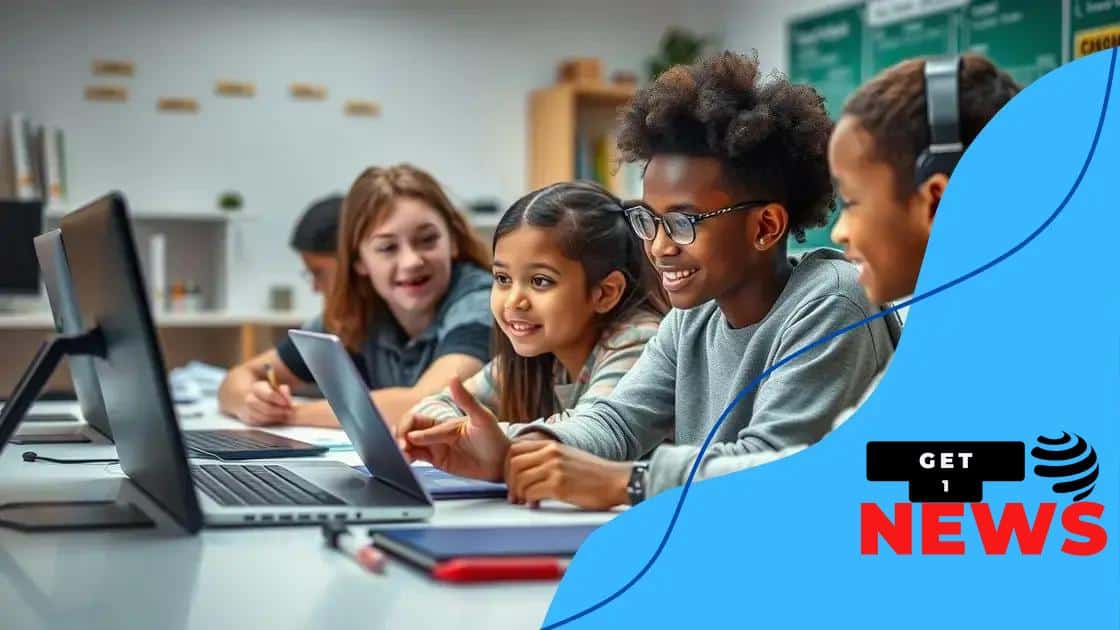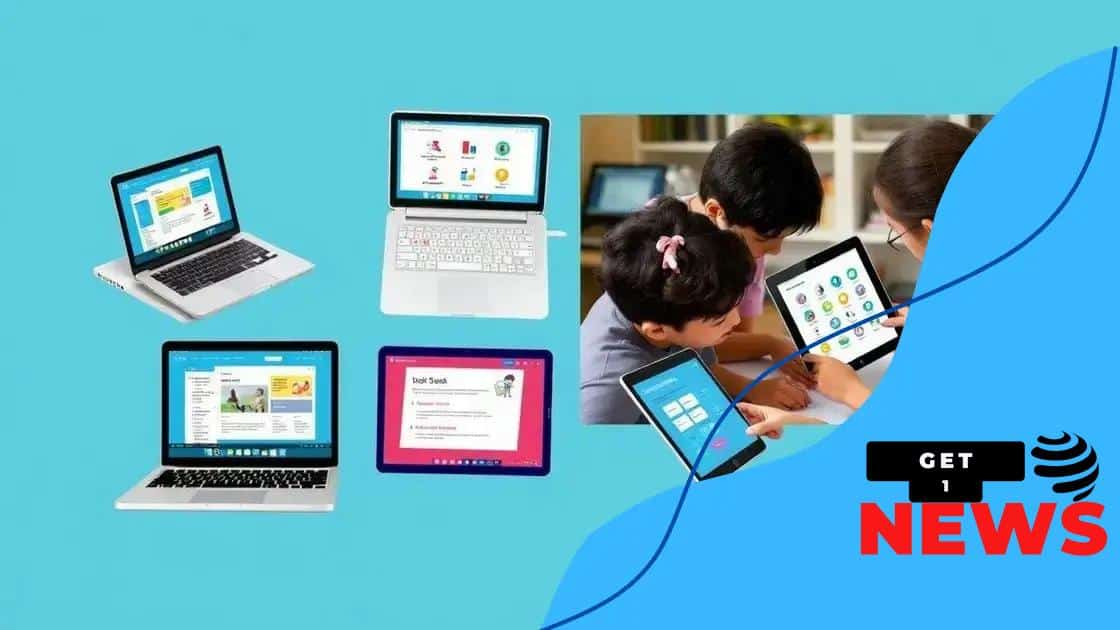Collaborative digital classrooms: shaping modern learning

Creating digital collaborative spaces involves addressing challenges such as technology access, communication barriers, and group dynamics to foster effective teamwork and engagement among students.
Collaborative digital classrooms are revolutionizing how students engage and learn. Imagine a space where technology fosters teamwork and creativity, enhancing the educational experience. Curious about how this impacts your learning journey? Let’s dive in!
Understanding collaborative digital classrooms
Understanding collaborative digital classrooms is essential for modern education. These spaces leverage technology to create interactive learning experiences for students. By integrating digital tools, teachers can promote collaboration among students, allowing them to work together effectively, regardless of their physical location.
The Role of Technology
Technology serves as the backbone of collaborative digital classrooms. Tools such as video conferencing, shared documents, and interactive platforms encourage participation. These resources help break down barriers, making learning more accessible and engaging.
Key Components of Collaborative Learning
- Real-time communication: Enables instant interaction through chat or video.
- Shared resources: Provides access to documents and presentations for all participants.
- Group projects: Encourages teamwork and fosters a sense of community.
- Feedback mechanisms: Allows students to give and receive input regularly.
Furthermore, collaborative digital classrooms cultivate essential skills like problem-solving and critical thinking. Students learn to articulate their ideas, respect differing viewpoints, and negotiate solutions with their peers. This environment not only enhances academic achievement but also prepares students for real-world challenges where teamwork is crucial.
Additionally, these classrooms promote inclusivity, catering to diverse learning styles. Teachers can tailor activities to suit individual needs, ensuring that all students can participate meaningfully. This flexibility is vital in fostering an atmosphere where every learner feels valued and empowered.
Implementing Collaborative Strategies
To foster a successful collaborative digital classroom, educators should consider adopting specific strategies. Mastering the use of digital tools is only the beginning; creating a supportive environment also plays a vital role.
- Encourage participation: Motivate all students to engage in discussions and share their perspectives.
- Set clear expectations: Clearly outline goals and responsibilities for group activities.
- Use diverse methods: Incorporate varied instructional methods to meet diverse needs.
In conclusion, understanding how collaborative digital classrooms function allows educators to enhance their teaching practices. By utilizing technology and fostering a collaborative spirit, students can thrive in a learning environment that mirrors the interconnected world we live in.
Benefits of collaborative learning environments
The benefits of collaborative learning environments are numerous and impactful. These settings not only enhance student engagement but also foster essential skills that are vital for success in today’s world. When students learn together, they share ideas and develop a deeper understanding of the material.
Enhanced Engagement
One significant advantage is increased engagement. Students are more likely to participate actively when they collaborate with their peers. This active involvement leads to a stronger connection with the content. When students discuss concepts, they motivate one another and create an environment of learning and curiosity.
Development of Critical Skills
- Teamwork: Students learn how to work effectively in groups, honing their ability to cooperate and collaborate.
- Communication: Sharing ideas and presenting perspectives enhances their communication skills.
- Problem-Solving: Working together on projects develops critical thinking and problem-solving abilities.
Additionally, collaborative learning environments can lead to improved academic performance. Research shows that students who engage in collaborative work tend to achieve higher grades. When learners receive immediate feedback from their peers, they can quickly understand different viewpoints, making learning more dynamic.
The sense of community found in these environments also reduces feelings of isolation. In a collaborative classroom, students often feel more supported and understood. This support can encourage risk-taking in learning, where students may feel more comfortable asking questions and expressing their ideas.
Diverse Perspectives
Furthermore, collaboration exposes students to diverse perspectives. When students from different backgrounds work together, they learn to appreciate the value of varied viewpoints. This exposure cultivates empathy and cultural understanding, essential in our increasingly global society.
- Exposure to diversity: Students learn to respect and include diverse opinions.
- Broader knowledge: Working with peers allows students to gain insights from each other.
- Empathy building: Collaborating helps students understand different experiences and viewpoints.
In summary, the benefits of collaborative learning environments extend beyond academics. By promoting engagement, critical skills, and diverse perspectives, these settings empower students to become well-rounded individuals prepared for future challenges.
Effective tools for digital collaboration

Effective tools for digital collaboration are crucial in today’s educational landscape. These tools enhance communication, streamline workflow, and connect students and teachers in meaningful ways. With the right resources, collaboration becomes seamless and productive.
Popular Collaboration Tools
Many tools are available to support collaborative learning. Each has unique features that cater to different needs in a digital classroom environment. For example, software like Google Workspace enables students to work together in real time, editing documents and sharing ideas effortlessly.
Key Features of Effective Tools
- Real-time editing: Allows multiple users to edit documents simultaneously.
- File sharing: Facilitates easy sharing of resources and materials.
- Video conferencing: Provides a platform for virtual meetings and discussions.
Moreover, some tools offer features that cater specifically to group projects. For instance, Trello is excellent for organizing tasks and deadlines, ensuring that everyone stays on track. Using such tools, students can assign tasks to each other and keep everything transparent. This transparency helps build accountability within the group, encouraging each member to contribute actively.
Integrating effective tools also promotes creativity. Applications like Padlet allow students to brainstorm and gather ideas visually. Students can add images, links, and notes on a shared board, creating an engaging atmosphere for collaboration.
Choosing the Right Tool
When selecting tools for digital collaboration, it’s essential to consider the specific needs of the classroom. Not every tool suits every scenario. Consider factors such as the type of activity, the number of participants, and the technology available to students. Additionally, training and familiarity with the tools can impact their effectiveness.
- User-friendly interface: Tools should be intuitive and easy to navigate.
- Compatibility: Ensure the tools work well with existing technology.
- Support and resources: Access to tutorials can enhance user experience.
Ultimately, employing the right tools will empower students to collaborate more effectively. With a robust set of tools at their disposal, learners can engage deeply with their peers and the material, leading to enriched educational experiences.
Implementing collaborative strategies in education
Implementing collaborative strategies in education is essential for creating effective learning environments. These strategies encourage students to work together, promoting active participation and a deeper understanding of subject matter. When done right, collaboration can transform how students learn and interact with each other.
Creating a Supportive Environment
To foster collaboration, teachers should create a supportive classroom environment. This involves establishing clear expectations and norms that guide group interactions. When students feel safe to express their ideas and opinions, they are more likely to participate fully in collaborative activities.
Setting Clear Goals
Another key aspect is setting clear goals for collaborative tasks. Effective strategies begin with defining what students should achieve. Goals should be specific, measurable, and attainable, ensuring that all group members understand their roles and responsibilities.
- Define roles: Assign specific roles within the group to promote accountability.
- Use rubrics: Provide assessment criteria that outline expectations.
- Encourage reflection: Allow time for students to discuss what they learn from collaboration.
In addition to structured tasks, using technology can enhance collaboration. Digital tools like discussion boards and collaborative software create opportunities for continuous interaction outside the classroom. These platforms allow students to share resources, provide feedback, and discuss ideas at their convenience.
Moreover, incorporating varied group activities can keep students engaged. Activities such as peer teaching, group discussions, and project-based learning not only make learning enjoyable but also help students develop critical social skills. Adapting collaboration methods based on group dynamics can lead to more successful outcomes.
Feedback and Improvement
Feedback is essential in collaborative strategies. Regularly assessing group performance enables students to understand what works and what needs improvement. Teachers should provide constructive feedback on both the group process and the content of their work. This ongoing assessment fosters a culture of continuous learning.
- Encourage peer feedback: Allow students to give input on each other’s contributions.
- Use self-assessment: Provide tools for students to reflect on their work.
- Share successes: Celebrate collaborative achievements to motivate students.
Ultimately, implementing collaborative strategies in education requires thoughtful planning and flexibility. By enriching the learning experience and cultivating a culture of teamwork, educators can prepare students for future challenges in a collaborative world.
Challenges in creating digital collaborative spaces
Creating digital collaborative spaces presents several challenges that educators must navigate. While technology offers many opportunities, implementing effective collaboration online can be complex. Understanding these challenges helps in finding solutions that foster a better learning environment.
Technological Barriers
One of the primary challenges is the issue of technology access. Not all students have reliable access to high-speed internet or devices needed for participation. This digital divide can create gaps between students, impacting their ability to engage equally in collaborative tasks.
Adapting to New Tools
Another challenge is getting everyone comfortable with using various digital tools. Students may have different levels of experience with technology, leading to frustration or disengagement. Educators must invest time in training students and providing support to ensure everyone can utilize the tools effectively.
- Training sessions: Organizing tutorials to familiarize students with platforms.
- Peer support: Encouraging students to help one another learn the tools.
- Continuous feedback: Gathering input on tool effectiveness to adjust training as needed.
Alongside technological barriers, communication can also pose significant challenges. In virtual collaborative spaces, non-verbal cues are often missing, making it difficult for students to interpret each other’s responses. This situation can lead to misunderstandings and conflicts during group work.
Additionally, maintaining engagement in a digital environment can be tough. Students may feel isolated or distracted without a physical classroom. The lack of face-to-face interaction might result in lower participation levels, making it essential to implement strategies that keep students engaged during collaborative activities.
Balancing Group Dynamics
Another issue is the dynamics within groups. Virtual collaboration can sometimes amplify issues related to leadership and participation. Some students might take control, while others may remain passive. To address this, educators need to set clear expectations about roles and responsibilities from the start.
- Clear roles: Assign specific tasks to each group member to ensure equal participation.
- Regular check-ins: Schedule frequent meetings to discuss progress and address concerns.
- Encourage inclusivity: Foster an environment where every voice is heard and valued.
In summary, recognizing these challenges in creating digital collaborative spaces allows educators to adapt their strategies effectively. By addressing access issues, providing adequate training, enhancing communication, and maintaining engagement, educators can create a more equitable and effective collaborative environment.
digital collaborative spaces is both exciting and challenging. By understanding the barriers and applying effective strategies, educators can enhance student collaboration. It’s vital to provide access to technology, ensure everyone feels comfortable with the tools, and maintain communication among students. Emphasizing engagement and adaptability in group dynamics will foster a more inclusive learning environment. Together, these efforts can lead to successful collaborative experiences that benefit all students.
FAQ – Questions about Creating Digital Collaborative Spaces
What are the main challenges in creating digital collaborative spaces?
The main challenges include ensuring technology access, adapting students to new tools, maintaining effective communication, and balancing group dynamics.
How can educators support students in using collaboration tools?
Educators can provide training sessions, encourage peer support, and offer continuous feedback to help students become comfortable with the tools.
Why is communication important in digital collaboration?
Communication is crucial as it helps prevent misunderstandings and ensures that all group members are on the same page during collaborative tasks.
What strategies can promote inclusivity in group work?
Assigning clear roles, encouraging participation from all members, and fostering a supportive environment can promote inclusivity in group work.





